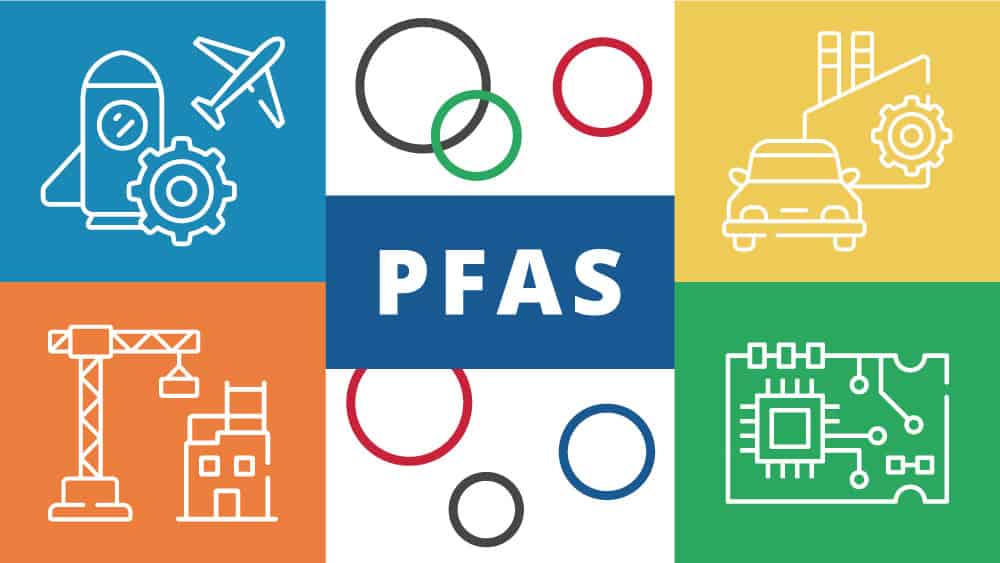PFAS is short for per- and polyfluoroalkyl substances, a large family of chemicals that are extremely persistent in the environment and our bodies.
Today, PFAS is one of the biggest threats in drinking water. The chemical class contains water- and stain-resistant synthetic compounds that can be difficult to break down in the environment and the human body. This high level of resistance comes from their firm, stable molecular structure. However, their non-stick qualities make them useful in products such as tents, umbrellas, food wrappers, carpets, and firefighting foam. They are also used to produce plastic and rubber.
In short, PFAS is all around us. Heck, it is even present in our blood. And when we think it couldn’t get any worse, a recent study published by the Environmental Working Group (EWG) shows that PFAS is also incredibly prevalent and persistent in tap water.
Scientists are still learning about the health effects of long-term exposure to most types of PFAS, but the few well-documented effects are worth highlighting. In this article, we’ll look closer at the impacts individually, so that you can better keep you and your family safe.
First of all, how do PFASs get into tap water?
According to the EWG, over 1,500 drinking water systems that serve nearly 110 million Americans may contain PFAS. But how come? How did these chemicals manage to get into so many drinking water systems?

Well, PFASs come from a wide range of sources. These chemicals can quickly get into the environment directly from landfills where products such as textiles and carpets break down and leach into the air, soil, and water. They can also enter the environment indirectly when the parent chemicals break down to form perfluorooctanoic acid (PFOA) and perfluorooctanesulfonic acid (PFOS).
According to studies, PFASs linger long after their production and use. Evidence also suggests that PFOS, PFOA, and other PFASs remained in groundwater for up to 15 years following the end of firefighting procedures in Michigan.
Some PFASs are present in some plants and animals. Because of their persistence, high solubility, and other traits, they can move about quickly in soil, making them prone to leaching into rivers, lakes, and groundwater supplies, and traveling long distances. Besides, PFASs can pollute different environments such as wastewater treatment plants, landfills, and even remote areas like the deep sea and the Arctic. Considering that, it’s no surprise that these chemicals can easily end up in your drinking water.
Okay, so what are the potential effects of exposure to PFAS chemicals in drinking water?
When you drink PFAS-contaminated water, small amounts of the sub-chemicals can bioaccumulate in your body over time. In other words, they can persist in the body even after the exposure stops. Evidence shows that even low levels of PFAS exposure may not be entirely safe for human health. On top of that, the EWG suggests that a sample that exceeds 1 part per trillion (ppt) could be potentially harmful.
Studies carried out on laboratory animals, supported by some evidence from studies on humans, indicate that exposure to specific PFAS over certain levels could result in adverse health effects. Although more research is needed, some studies have shown that common PFAS like PFOA and PFOS may cause the following health impacts:
1. High Cholesterol, Weight Gain, and Thyroid Disease
Exposure to PFASs can cause high cholesterol, weight gain, and thyroid disease. PFOA is associated with reproductive problems like pregnancy-induced hypertension and decreased fertility. Science experts concluded that increased exposure to PFOA might correlate with decreases in birth weight, as well as adverse effects on the liver and the immune system. PFOA might also lead to neurobehavioral impacts such as ADHD and endocrine disruption.
2. Cancer
The International Agency for Research on Cancer, the cancer research arm of the World Health Organization (WHO), classifies PFOA as a Group 2B carcinogen. The agency also classifies it as being potentially cancerous to humans. Further, the U.S. Environmental Protection Agency (EPA) concludes that the claims of the carcinogenicity of PFOA in humans might be valid, due to “suggestive evidence.” An observatory test involving humans who ingested the chemical compound concluded that the participants showed similar increases in testicular and kidney cancer.
3. Other Known Possible Health Effects
PFASs are also known to affect growth, learning, and behavior in infants and older children. Besides, the chemicals can lead to increases in blood pressure in pregnant women, nerve disorders, lower infant birth weights, and functional problems with the body’s natural hormones.
What can I do about PFAS in drinking water?
Since there are no federal regulatory levels set for PFAS (although some states have established their guidance and screen levels), you might have to take matters into your own hands to protect your home and your family. If you suspect that you or a family member potentially consumed water that contained PFAS, you should contact your family’s healthcare provider immediately. If you are pregnant and you’ve been exposed to PFAS-contaminated water, tell your obstetrician, so that they can monitor your blood pressure more closely.
Testing your drinking water is the best way to determine if your water contains PFAS. There are several affordable water testing kits available online for purchase. Buy one and check your water for possible PFAS contamination in no time. At-home testing takes less than 10 minutes. Alternatively, you can take a sample from your tap and send it to a local laboratory for testing. You can even contact your local water provider and request a copy of the latest water quality report, then scan through it to see if there have been any recent reports of PFAS in the water supply in your area.
Testing your water is especially important if you’ve noticed that your water tastes “off,” it is not clear, is has an unpleasant odor, or your water bills have increased unexpectedly. Besides, checking your water quality can help you take the right steps to purify your water before any possible contamination gets worse, so you can provide safer and cleaner drinking water for your home and your loved ones.
For PFAS, the best solution is any top-performing water filtration system, such as the Springwell CF1 Whole House Water Filtration System. This specific system can significantly reduce harmful contaminants in your water, such as chlorine, chloramine, PFOA, PFAS PFOS, pesticides, herbicides, haloacetic acids, and more. The CF1 uses ActivFlo technology to filter your water through four critical stages. For added protection you could opp for a reverse osmosis system as well.
To learn more about other powerful and unique water filtration systems distributed by Song Phung, order online at the website https://thietbinganhnuoc.com/san-pham or call hotline 0913.90.72.74 – 0984.620.494 to be consulted in detail.
Follow Fanpage: https://www.facebook.com/SongPhungthietbinganhnuoc/ to update new products
Learn more: Pool filter sand replacement service
Translator: Duong Nguyen Hoang Khang


